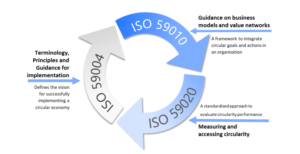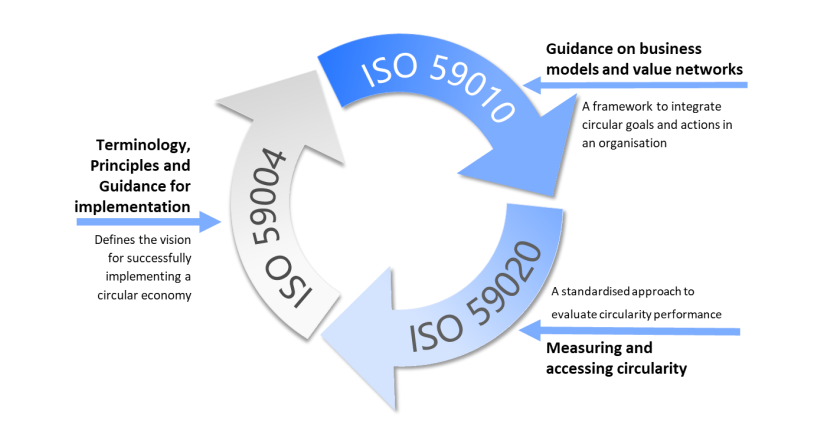“The essence of the circular economy is to redefine the way we consider growth”: Unknown.
Introduction
Imagine you own a smartphone. In a linear economy, the typical life cycle of your phone would be raw materials are extracted, the phone is manufactured, you use it, and once it’s outdated or broken, it’s discarded, contributing to e-waste. In a circular economy, the process would be different. The focus will be on design for durability, how to reuse and repair it, how we can recycle it and what are the possibilities for resale/sharing.
Content: What is ISO 59000 Series related to the Circular Economy
- What is ISO 59004, ISO 59010 and ISO 59020 Standard
- Why these standards are important
- What are their key benefits
- Conclusion
Objective
As an economic model that maintains resources in circulation by recovering, retaining or adding value, a circular economy promotes sustainable development and significantly aids decarbonization efforts. The newly published standards are a significant milestone, providing a common global understanding of the definition of circular economy, business operations according to the economic model, and its monitoring and evaluation.
Once you go through the article, you will understand the meaning of these 3 standards (ISO 59004, ISO 59010 and ISO 59020), why they are important and what can be the possible benefits.
Read More: https://bit.ly/LinearCircularEconomy
Definition: ISO 59004: 2024
Circular Economy (Cl 3.1.1): Economic system that uses a systematic approach to maintain a circular flow of resources by recovering, retaining or adding to their value while contributing to sustainable development.
Sustainable Development (Cl 3.1.11): Development that meets the environmental, social economic needs of the present without compromising the ability of the future generations to meet their own needs.
Life Cycle (Cl 3.2.4): Consecutive and interlinked stages in the life of a solution.
Linear Economy (Cl 3.5.10): Economic system where resources typically follow the pattern of extraction, production, use and disposal.
End of Life (Cl 3.5.30): <Product> point in time when a product is taken out of use and its resources are either recovered for processing or disposed of.
Life Cycle Assessment (Cl 3.6.8): Compilation and evaluation of the inputs, outputs and potential environmental impacts of a product system throughout its life cycle.
Read More: https://bit.ly/ReduceRecyleReuse
Detailed Information
As the world increasingly faces an urgent need to shift towards a more sustainable and regenerative economic model, the ISO 59000 family of standards emerges as a powerful catalyst for change. These comprehensive guidelines empower companies worldwide. Not only do they provide a roadmap for embracing the circular economy, but they also foster responsible resource management and drive innovation on a global scale.
On 22 May 2024, the International Organization for Standardization (ISO) published a new family of standards to guide the transition to the circular economy. The standards mark the first set of international definitions and rules for the circular economy. Organizations from more than a hundred countries were involved in their preparation. This document was prepared by Technical Committee ISO/TC 323, Circular Economy.
Read More: https://bit.ly/ClimateChnages
What is ISO 59004?
ISO 59004 is a part of the ISO 59000 family of standards, specifically designed to foster a shift towards a circular economy.
- This standard provides comprehensive guidance applicable to any type of organization. It includes defining key terms and concepts, outlining a vision for a circular economy, elucidating core principles, and offering practical guidance for actionable steps towards sustainability.
- The standard aims to support organizations in contributing to the United Nations Agenda 2030 for Sustainable Development by facilitating a transition to a circular use of resources.
Why is ISO 59004 important?
The linear model of the global economy—characterized by extraction, production, use, and disposal—has led to significant environmental challenges, including resource depletion climate change and biodiversity loss. This standard addresses these issues by advocating for a circular economy model, which emphasizes the sustainable management and renewal of natural resources. By adopting this standard, organizations can:
- Deliver more sustainable and ambitious solutions.
- Improve relationships with stakeholders.
- Engage in more effective and efficient fulfilment of voluntary and legal obligations.
- Contribute to climate change mitigation and adaptation.
- Increase resilience against resource scarcity and other environmental, social, and economic risks.
Adherence to ISO 59004 enables organizations to create and share more value within society while ensuring the quality and resilience of ecosystems, ultimately supporting a sustainable future.
Benefits:
- Sustainable resource management
- Enhanced stakeholder relationships
- Better compliance with environmental regulations
- Contribution to climate change mitigation
- Increased organizational resilience
What is ISO 59010?
ISO 59010 guides organizations wishing to transition their value creation models and networks from a linear to a circular framework.
- This standard focuses on business-oriented strategies to implement circular economy practices at both organizational and inter-organizational levels.
- It complements ISO 59004 by offering more detailed guidance on assessing current value creation models, mapping value chains and value networks, and developing strategies for circularity.
- ISO 59010 is designed to help organizations make this transition effectively, contributing to sustainable business practices and a resilient global economy.
Why is ISO 59010 important?
ISO 59010 is vital as it guides organizations in transforming their linear value creation models into circular ones, crucial for sustainable development.
- It addresses the pressing need to mitigate environmental risks, manage resource depletion, and respond to regulatory and consumer pressures for sustainability.
- For businesses, it outlines a structured approach to integrating circular economy principles, enhancing resource efficiency and creating economic opportunities through innovation and resilience.
Benefits:
- Improved resource efficiency and waste reduction
- Enhanced adaptability to regulatory and market changes
- Better alignment of business practices with global sustainability goals
- Increased competitive advantage and stakeholder trust
What is ISO 59020?
ISO 59020 sets forth requirements and guidance for organizations to measure and assess their circularity performance within defined economic systems.
- This document aims to standardize the process by which organizations collect and calculate data using mandatory and optional circularity indicators, ensuring consistent and verifiable results.
- It provides a structured framework for setting system boundaries, selecting appropriate indicators, and interpreting data to evaluate the circularity performance at multiple levels—from regional and inter-organizational to organizational and product-specific levels.
Why is ISO 59020 important?
ISO 59020 is crucial in transitioning towards a more circular economy by providing a clear and structured methodology for measuring and assessing circularity performance.
- It helps organizations identify how effectively they are minimizing resource use and optimizing the circular flow of materials.
- This standard not only aids in achieving environmental sustainability but also supports the broader goals of sustainable development by aligning with the United Nations Agenda 2030 and the Sustainable Development Goals (SDGs).
- For businesses, it offers a way to quantify progress and demonstrate commitment to sustainable practices, enhancing transparency, accountability, and stakeholder trust.
Benefits:
- Provides a clear framework for measuring circularity performance.
- Helps organizations align with global sustainability goals
- Enhances transparency and accountability in environmental reporting
- Supports strategic decision-making for sustainable resource management
Conclusion:
The ISO 59000 series is not just a set of guidelines – it’s a roadmap to the future of sustainable business. By adopting these standards, the organizations can position themselves for long-term success, aligning with global sustainability goals and driving significant competitive advantages. The time to act is now.
Read More: http://bit.ly/CommonSpecialCause
References:
ISO 59004: 2024
ISO 59010: 2024
ISO 59020: 2024
Industry Experts
This is the 221st article of this Quality Management series. Every weekend, you will find useful information that will make your Management System journey Productive. Please share it with your colleagues too.
In the words of Albert Einstein, “The important thing is never to stop questioning.” I invite you to ask anything about the above subject. Questions and answers are the lifeblood of learning, and we are all learning. I will answer all questions to the best of my ability and promise to keep personal information confidential.
Your genuine feedback and response are extremely valuable. Please suggest topics for the coming weeks.
